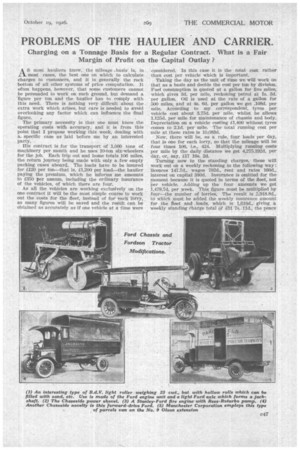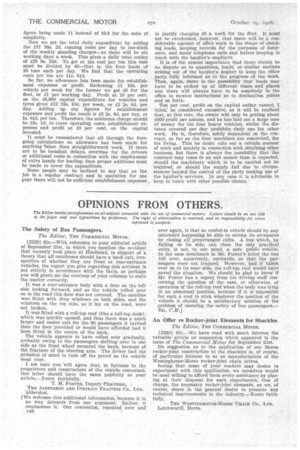PROBLEMS OF THE HAULIER AND CARRIER.
Page 77

Page 78

If you've noticed an error in this article please click here to report it so we can fix it.
Charging on a Tonnage Basis for a Regular Contract. What is a Fair Margin of Profit on the Capital Outlay ?
AS most hauliers know, the mileage basis is, in most cases, the best one on which to calculate: charges to eustoniers, and it is generally the rock bottom of all other systems of price computation. It often happens, however, that some customers cannot be persuaded to work on such ground, but demand a figure per ton and the haulier has to comply with this need. There is nothing very difficult about the extra work which arises, but care is needed to avoid overlooking any factor which can influence the final figure.
The primary necessity is that one must know the operating costs with accuracy, and it is from this point that I propose working this Week, dealing with a-• specific case as laid before me by an interested party.
His contract is for the transport of 1,000 tens of machinery per month and he uses 10-ton six-wheelers for the job. Each trip out and home totals 106 miles, the return journey being made with only a few empty packing cases aboard. The loads have to be insured for £120 per ton—that is, £1,200 per load—the haulier paying the premium, which he informs me amounts to £350 per annum, including the ordinary insurance of the vehicles, of which there are four.
As all the vehicles are working exclusively on the one contract it will be the most simple course to work out the costs for the fleet, instead of for each lorry, as many figures will be saved and the result can be obtained as accurately as if one vehicle at a time were Considered. In this case it is the total cost rather than cost per vehicle which is important.
Ta.king the day as the unit of time we will work On that as a basis and decide the cost per ton by division. Fuel consumption is quoted at a gallon far five miles; which gives 3d. per mile, reckoning petrol it 1s. 3d. per gallon. Oil is used at the rate of a gallon for 500 miles, and at 4s. 6d. per gallon we get .108d. per mile. According to my correspondent, tyres per vehicle cost about 3.75d. per mile, whilst he allows 1.125d. per mile for maintenance of chassis and body. Depreciation on a vehicle costing £1,400 without tyres comes to 2.1d. per mile. The total running cost per mile at these rates is 10.083d.
Now, there will be, as a rule, four loads per day, that is one for each lorry, so that the mileage will be four times 106, i.e., 424. Multiplying running costs per mile by the daily distance we get 4,275.1924. per day, or, say, £17 16s. 24.
Turning now to the standing charges;these will work out on a weekly reekcining in the following way: licences 147.74., wages 792d., rent and rates 160d., interest On capital 3804. Insurance is omitted for the moment because it is quoted interms of the fleet, not Per vehicle. Adding up the four amounts we get 1,479.74. per week. Tbis figure must be multiplied by four—the number of lorries. The result is 5,918.84., 1-.6 *Well must be added, the weekly insurance amount for the fleet and loads, which is 1,6I64., giving a weekly standing charge total Of £31 7s. .114., the pence
figure being made 11' instead of 10.8 for the sake of simplicity.
Now we get the total daily expenditure by adding the £17 16s. 2d. running costs per day to one-sixth of the weekly standing charges—as there will be six working days a week. This gives a daily total outlay of £23 Os. 10t1. To get at the cost per ton this sum must be divided by 40—that is, the four loads of 10 tons each per day. We find that the operating costs per ton are 11s. 64d.
So far, no allowance has been made for establish ment expenses or profit. Reckoning 10s. per vehicle per week for the former we get £6 for the fleet, or £1 per working day. Profit at 10 per cent. on the £6,600 capital expenditure for vehicles and tyres gives £12 13s. 10d. per week, or £2 2s. 6d. per day. Adding up Our figures for establishment expenses and profit the result is £3 2s. 6d. per day, or Is. aid. per ton. Therefore, the minimum charge should be 13s. id. to cover operating costs, establishment expenses and profit at 10 per cent, on the capital invested.
It must be remembered that all through the foregoing calculations no allowance has been made for anything 'other than straightforward work. If there are to be terminal delays, overtime for the drivers or additional costs in connection with the employment of extra hands for loading, then proper additions must be made to cover the expenditure.
• Some people may be inclined to say that as the job is a regular contract and in operation for one year there will not be sufficient establishment expenses to justify charging £6 a week for the fleet. It must not be overlooked, however, that there will be a considerable amount of office work in the shape of checking loads, keeping records for the purposes of insurance, and many telephone calls and letters keeping in touch with the haulier's employer.
It is of the utmost importance that there should be no dispute as to quantities, loads, or similar matters arising out of the haulier's neglect to keep the other party fully informed as to the progress of the work. Then, again, there is the possibility that loads may have to be picked up at different times and places and there will always have to be somebody in the office to receive instructions as to destination points and so forth.
Ten per cent, profit on the capital outlay cannot, I think; be considered excessive, as it will be realized that, at this rate, the owner will only be getting about £660 profit per annum, and he has laid out a large sum of money for his four heavy vehicles, whilst the distance coveredper day prohibits their use for other work. He is, therefore, solely dependent on the contract, so far as the four machines are concerned, for us living. This no doubt cuts out a certain amount of work and anxiety in connection with obtaining other business, but there is always the possibility that the contract may come CO an end sooner than is expected, should the machinery which is to be carried not be required, or should the supply fail due to circumtances beyond the control of the party making use of he haulier's services. In any case it is advisable to keep in touch with other possible clients.'




























































































































